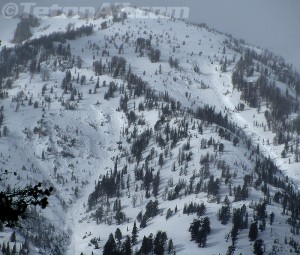 Barring multiple avalanche warnings and overall sketchy snow conditions, it’s petty hard to sit around the house or wait in lift-lines with a bazillion other skiers, and I’ve been trying to get out into the backcountry and ski what is available…without getting killed in the process. After getting denied and turning around at 8k’ in the park a couple days ago due to wind, weather and yeah, extreme avalanche danger, I skied the pass yesterday, but felt the need to get out into the park again today and do some snow control on the areas I like to ski most. The reported 9†of new light density snow meant the skiing would be killer! How could I resist?
Barring multiple avalanche warnings and overall sketchy snow conditions, it’s petty hard to sit around the house or wait in lift-lines with a bazillion other skiers, and I’ve been trying to get out into the backcountry and ski what is available…without getting killed in the process. After getting denied and turning around at 8k’ in the park a couple days ago due to wind, weather and yeah, extreme avalanche danger, I skied the pass yesterday, but felt the need to get out into the park again today and do some snow control on the areas I like to ski most. The reported 9†of new light density snow meant the skiing would be killer! How could I resist?
Clearing skies and cold temps kept the stoke level high as our group moved into the more open terrain below Wimpys. The cold temps made travel so much easier than just a couple days before, when the guy breaking trail would sink well above their knees in the sugary snowpack. We moved smoothly through the lower field this time, and then proceeded to get on the lower, steeper flanks of the Wimpster.
It was at this point were my partner and I had turned around two days earlier, as the shooting cracks and extremely audible whumps, and general settling of the snowpack, was just too much to bear. Knowing the terrain and history of slides on Wimpys however, I felt that if one were to stay in the relative safe zones, it was likely you could make it to the top of the run during high avalanche danger. But, it would definitely take a lot of nerve to keep pushing uphill as the slope continually warned you of its instability with every step you took. Today, I felt that I had a bit more nerve than the day before, so we moved up past our turn around point.
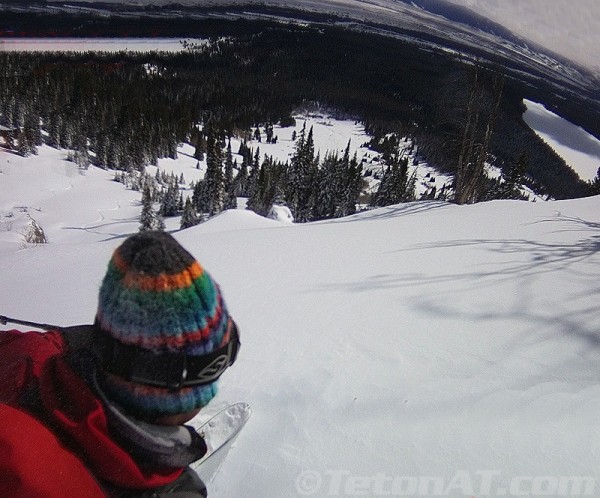
The lure of powder skiing.
Click all photos for larger image.
Breaking trail was surprisingly easy, but the settling of the snowpack was enough to drive the most seasoned backcountry skiers crazy. I tried not to think about the hazard though, and kept heading uphill. We spaced ourselves out as much as possible on the skin-track, to spread out our effect on the snowpack, and we soon found ourselves in safer, less exposed terrain. There relative safety of the trees was reassuring, as we weaved our way up higher.
Soon, we were in the upper bowl and it looked like we would get our “summitâ€, and that the skiing was going to be freaking awesome! I was getting stoked. There were a couple more spots of relative hazard we would need to pass, but I thought we had it. I gave up the lead and fell to the back of the line for a bit to enjoy the sun and dream about the pow that was about to be crushed.
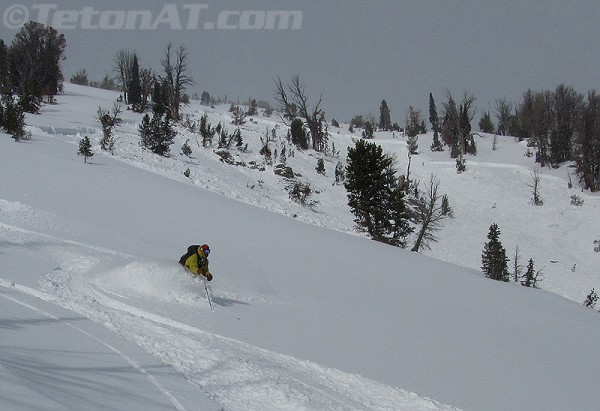
pow turns next to slide in upper bowl.
We kept our skin-track in the safe zones and in the trees as much as possible as we tried to make our way up the final bowl. As we approached one of the few final hazard-zones, a whump came from deep in the snowpack…and we heard it rumble away from us under our skis. I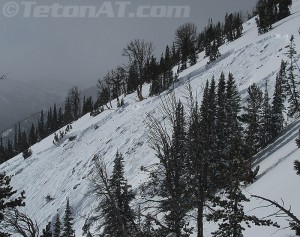 t stopped us in our tracks, and made us think once again if we should turn around or not. After talking and looking around for a bit, we finally saw the slide, and it dawned on us that we had just remotely trigged quite a large slide in the gut of Wimpys from 150-200’ away.
t stopped us in our tracks, and made us think once again if we should turn around or not. After talking and looking around for a bit, we finally saw the slide, and it dawned on us that we had just remotely trigged quite a large slide in the gut of Wimpys from 150-200’ away.
It was tempting to continue upward, since the slope had already slid and reaffirmed my thoughts as to the safe and unsafe zones on Wimpys, but we listen to reason and our inner voices and high-tailed it out of there, about 500’ from the top. Lower down, we saw another slide in what I call the middle-gully, which must have also pulled out when the upper bowl did as well…but was more like 2-300’ from our skin track. Pretty touchy snowpack to say the least.
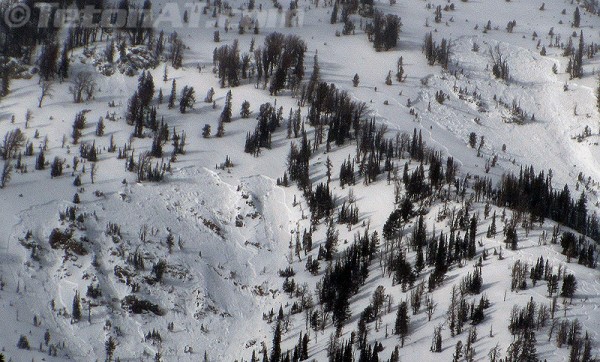
If you look close, you can see our ski tracks between the two slide paths.
Our skin track was in the trees just to the left of the
ski tracks when we remotely triggered the avalanches.
The ski down was awesome, as you can expect, and we ended up skinning back up to our highpoint for another lap. One might think this is extremely stupid, but like I said prior, the slides today reaffirmed my thoughts relating to the safe skiing and skinning zones on the route, which we stuck to…sorta.

Glad you didn’t die
thanks, fp. but i think i was far from death. well…at least 150-200′.
The last photograph showing both slides and your downtrack looks like Exhibit A for how to find a safe place to ski when there is instability. Good job.
How did you get that photograph?
Of course,you never know when a slide will propogate and pull closer too sections of the ridge you skiied (lookers right down track appears to be in the zone of what could propogate and pull out).
Did you have to cross the run outs either on the way up or out? How deep was the debris?
wyatt…there is this one spot, on the way back to the TH, that you can glance back and see the zone you have just skied…and where that shot was taken. i’m quite familiar with it.
granted about the propagation, but i’ve NEVER seen it pull out much further than it did today. deeper…yes.
http://tetonat.staging.wpengine.com/2010/01/07/avalanche-psa-albrightwimpys-massif/
no run-outs crossed. i think the deposition wasn’t very deep, as both zones tend to fan out when all is said and done. BUT, both areas would for sure funnel you through a tight choke and probably break your neck, so you’d be dead before suffocation ensued.
live to ski…eh?!
55 Avalanches reported in the area today(and that’s only the ones on jhavalanche). I’ve followed your website for a long time and have never made a comment. You’ve inspired countless people over the years! You set the example. 90% of people caught in avalanches can tell you exactly why they were caught. 2 deaths in BC in the last two days. Live to ski until you’re old!
Hey Steve,
Glad that your OKay. Sounds like around 1030 is when it went hey? Did the debris from the northernmost slide path split like it did last time? Did it cross the skin track again if it did?
B
BTW this cycle isn’t complete…at least from my perspective…Cheers!
“Live to ski until you’re old!”quoting Mike…guess I will let things rest a while longer. Back to the Vill for day 1 of 2012. Hopefully everyone stays home hangdoggy.
Man, glad that all is well, but I wish we could have that sort of scare down here in CO!
I sort of chuckle to myself yesterday when I looked out the window, seeing a brown Wasatch range, right after reading the avy report with the rating as “High”. How cool is it to have only a few feet of snow, but a “High” rating;)
This is the year of Yoda…….”Patience, you must have”.
hey bill. yeah…i think 1030-11.
the northern most slide path did split, i guess. basically the debris fans out quite a bit as it hits the lower angle terrain below the choke. it did not cross the skin-track though.
Hey Steve, I’m a huge fan of your blog and wouldn’t question anything normally since you’re certainly more of an expert than I, but I did note one technical inaccuracy in your description of the snowpack: you seem to use the terms “settlement” and “whoomphing” to refer to similar events occurring at the same time, but they are very different things. Settlement is the slow deformation of the snowpack under the effects of gravity that occurs over several days while whoomphing is a more rapid collapse. I know that most people who read your blog probably know the difference and understand what you’re writing about, but I mention this in case there’s someone who’s new to this is learning from what you’re writing. Of course, the most important point is that you made the right decisions on a high risk day and made it back OK, and that’s a lesson for all of us!
On page 52 of the 3rd edition of Bruce Tremper’s “Staying Alive in Avalanche Terrain” he write about this distinction:
“As sintering progresses, the snow becomes denser and stronger, which we call ‘settlement.’ Sometimes you will hear people incorrectly use the term ‘settlement’ to describe the catastrophic collapse of a snowpack that often makes a giant WHOOMPH sound, as in, ‘Hey, did you hear that settlement? Maybe we should get out of here.’ Instead, we call these collapses, or ‘whoomphing,’ which has been adopted as the technical term for a collapsing snowpack because it is such a great descriptive term. Settlement is the slow [italicized] deformation of the snow as it becomes denser and sags under the influence of gravity.”
Thanks for that Max…I did not know that.
Good work on getting some safe turns in rough times, that’s how I would have played it. I am wondering about how often that whole upper start zone goes and how bad things would have to be for that to happen, or if that is the type of thing that’s more likely go later in the season with more of a load on it and anchors more deeply buried? Is there any local knowledge of that upper zone going wall to wall in recent memory?
150-200′ is still pretty damn close, but a near miss is still a miss. I myself would prefer a slightly larger margin of safety. Glad you know your slopes and had luck on your side so that the warning that finally got your attention was still just a shot off the bow. Any lessons for the future or same game plan next time?
Settlement appears to be an out-of-favor technical term for what is now called “collapsing”. The term “settlement” seems more accurate to me, since the snowpack suddenly settles beneath your feet, but it is what it is. Clear and consistent nomenclature trumps aesthetics when it comes to communication.
To Tony’s question: I haven’t seen Wimpy’s pull out wall-to-wall and through Steve’s so-called “safe zone” in 35 years of skiing the Park, but the conditions are perfect for it. I recall a fracture line in the Selkirks of BC dutring a similar snowpack that was literally miles long, wrapping in and out of cirque after cirque as it crossed ridge lines and through thick tree clusters, nothing seeming to stem the release of energy from the weak snowpack. Once you have seen something like that, Steve’s “safe zone” is just a joke. Tony S wonders how bad it needs to be for a slide like that to happen….folks it is about as bad as it gets RIGHT NOW. I ponder the same question LePistoir does: Any lessons learned, Steve, or same game plan next time?
hey d-in-the-d…i’d say conditions would be ripe for a cataclysmic slide (like the one that made all those nice meadows down low) if you put another 6′ on it in a really short time 3-days ago. i doubt it’s that sketchy up there now, as i don’t think there is enough rocky terrain to really harbor the really bad snow. just my opinion of course…as a ski bum.
i think same game plan next time unless the snowpack is even more ripe for slides…which someday it could be. i don’t think we are at a oh-my-god moment quite yet.
Yeah, we are all just ski bums, there are no avie experts; the science is not exact enough due to all the variables, the biggest being should we even be out there sometimes! I agree we aren’t at an OMG moment presently, since we are back to high and dry, but this nastiness ain’t over yet. Steve, did you investigate the bed surface after the slides? Is the only thing left more facets and depth hoar for those paths to go big yet again? By the way, saw some avie activity in thick N trees at 8500 ft on the west slope that went sometime during/after the storm cycle. Scary!
DITD…i really need to use the semi-colon more. 😎
i didn’t investigate the bed surface. i’d feel pretty confident sending the gut if it snowed another 1′ though…even with some wind.
to some extent, i just don’t think it is steep enough for the zones that didn’t slide…to slide now.
i think the mid-elevations are what is most scary right now and terrain traps are definitely on my radar. i’ve seen lots of avy activity that went natural during the high danger cycle, with a zone between albright and static, sending a huge debris pile into the draw. it’s wild to think about these huge slides going big by themselves. maybe our 160lbs isn’t that big of a deal?
yeah…i know, tell that to the dude on pucker face. but that just seems like a bad idea in the first place, even though i hate judge from the armchair. however, his one turn did send all the snow downhill, which was nice since he wasn’t on it. unfortunately for him(?), it was in front of all the folks at jhmr to see it.
The Pucker Face dude brings up another feature of our current snowpack; seems that it is more often than not the 2nd, 3rd or later rider that triggers the release and not the first person to venture onto the slope when conditions are extremely rotten, shallow snow. My understanding is that he was number 2 on the face.
The big fascination to me is how all that rotten crap down there almost always stops being reactive at some point during a Wyoming winter, even without deep-pack bridging, and even though the bad crystals are still easy to find.
Maybe 160 lbs is a big deal: witness your remote releases that started this blog. I believe the big naturals went because of 3 inches of water content (lots of weight!)in the storm piling up quickly on a fragile pack. Your sympathetic slides only reinforce the message that those paths that didn’t go naturally don’t need much more stress to let go. The snowpack is adjusting and getting used to the new load, but I’m not eating alot of high calorie desserts!
Welcome to Colorado troops. I applaud every decision made by you and your group from the car to your turn around point and back to the car. GOOD JOB!!! “about as bad as it gets”? Not even close but stay tuned because if La Nina shows up it might.
the key point made here by DITD is should you have been there at all. i have taken the safe zone route befoe only to get blindsided. it was on a day that i should have been home playing with my kids. i know its hard, and i know that we all like to lay it on the line sometimes. but it has been extremely bad. should go mtn biking. glad you are alive and well.
i hear you beentheredunthat…and thanks. but when is it okay to risk it? considerable…moderate…low avy danger?
[…] it is whumps in the snowpack, unpredictable moose, or slick and icy spots, there can be some pretty darn scary moments when out […]